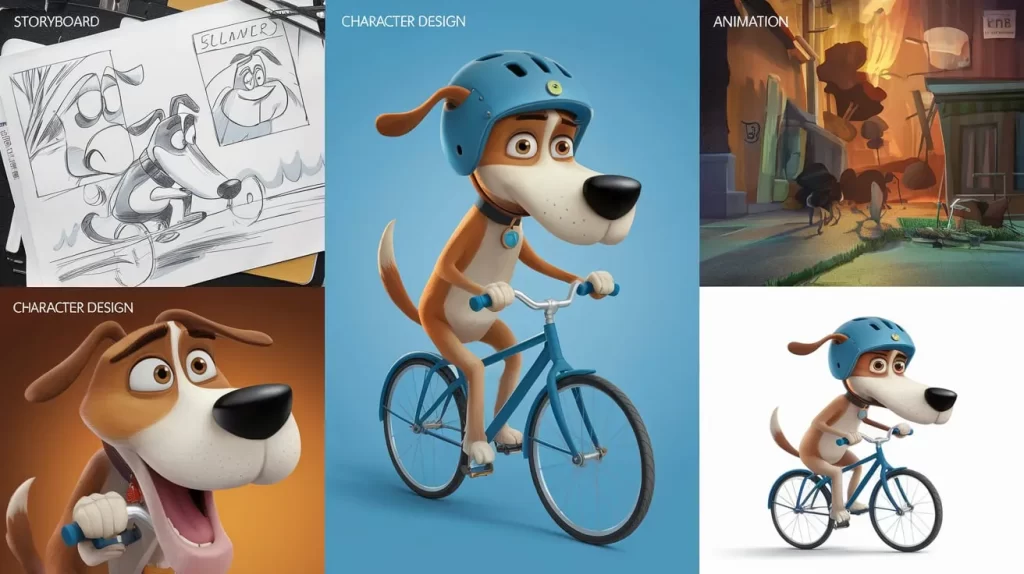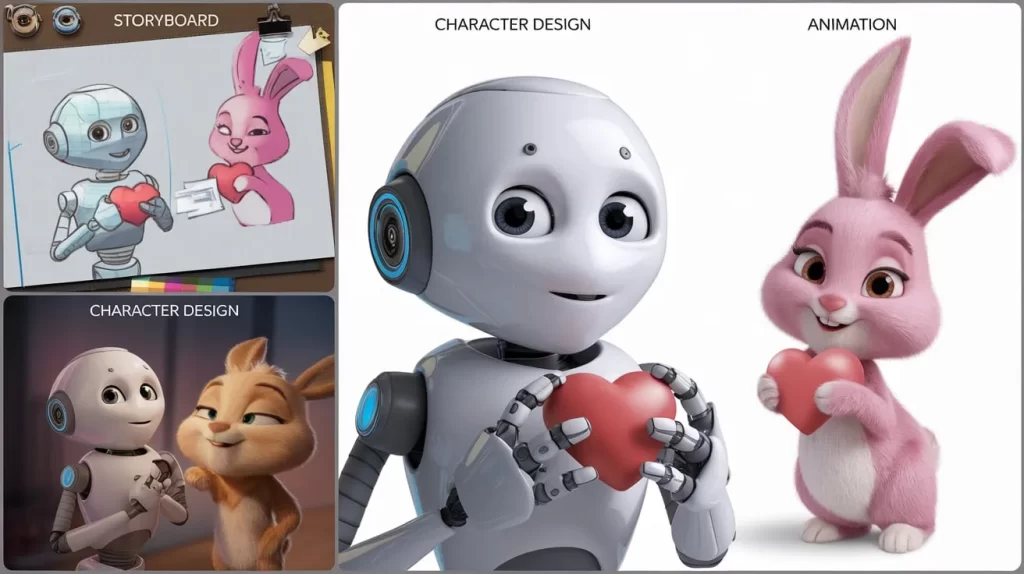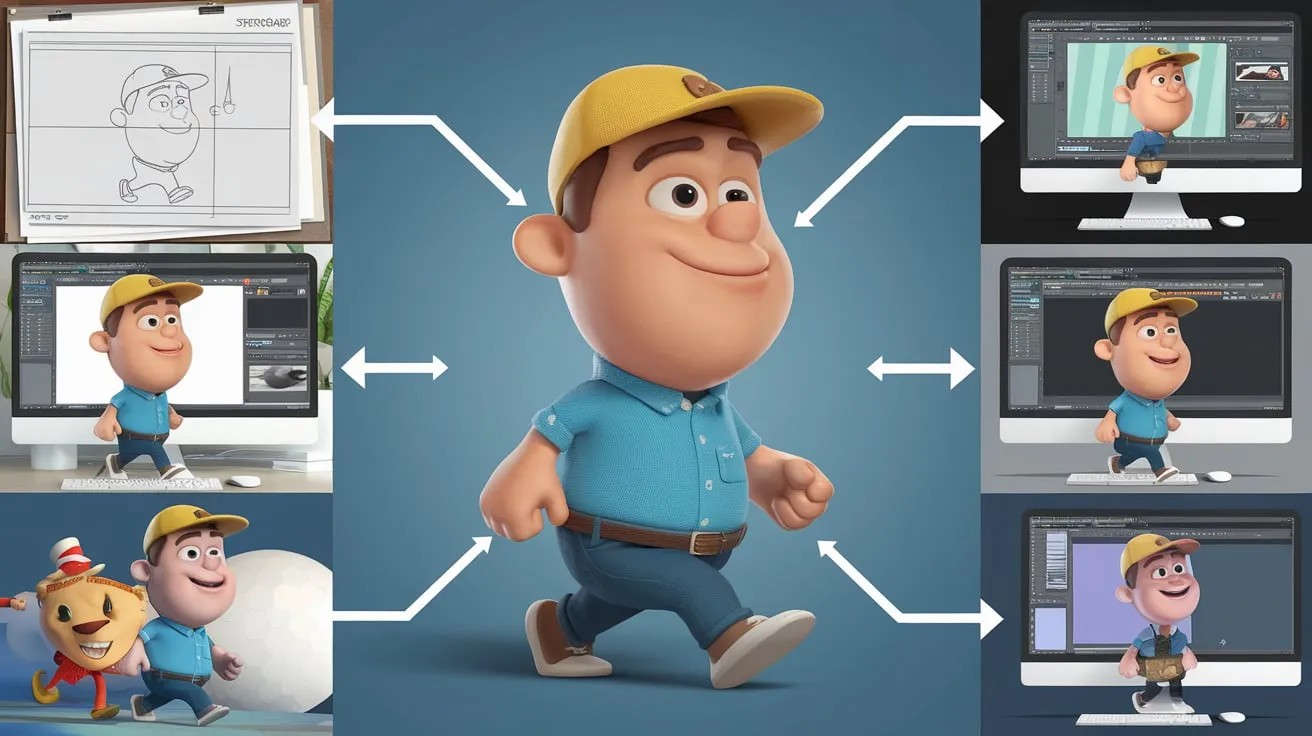Creating 2D animation is no small feat. It requires a harmonious blend of creativity, technology, and skilled craftsmanship. Whether you’re a seasoned animator or just beginning your journey, understanding the entire 2D animation process, from the initial concept to the final polished product, is essential for producing high-quality animations that captivate audiences. We’ll take a deep dive into the various stages of 2D animation, exploring each step of the pipeline, the key roles involved, and the techniques that bring animated worlds to life. By the end of this article, you’ll have a comprehensive understanding of the animation process, the tools animators use, and how each stage contributes to the finished product.

Overview of the 2D Animation Pipeline, From Idea to Finished Product
Creating 2D animation involves several distinct stages, often referred to as the animation pipeline. This pipeline outlines the step-by-step process required to take an idea from a rough concept to a fully realized animated project. Each stage is crucial, and skipping steps or rushing through them can compromise the final product. By following a structured process, animators can maintain quality, meet deadlines, and ensure that the vision comes to life in the best possible way.
In the world of 2D animation, the pipeline can typically be broken down into three main sections: pre-production, production, and post-production. Each phase has its own set of challenges, but all are integral in creating fluid, engaging animation.
Related Posts:
- Best 2D Animation Software: Choosing the Right Tool
- Advanced Techniques in 2D Animation
- Best 2D Animation Studios & Agencies
Pre-production
The pre-production phase is all about planning and setting the foundation for the animation. This stage includes everything from brainstorming the initial idea to designing characters and planning out the narrative. Without a solid pre-production process, animators risk encountering problems later on during production or post-production.
Conceptualization: Brainstorming Ideas and Creating Storyboards
Every great 2D animation starts with an idea. Whether it’s a short film, a commercial, or a web series, the first step is to develop the concept. This involves brainstorming ideas, defining the animation’s purpose, and visualizing the world in which the story takes place.
Once the core idea is decided, storyboarding comes next. A storyboard is a visual outline of the animation. It’s a series of sketches that map out the key scenes and actions in the animation, helping animators visualize the flow of the story. Storyboards are an essential part of the process because they help establish the timing, pacing, and structure of the animation before production begins.
During the conceptualization phase, animators and directors discuss key aspects of the animation such as tone, style, and setting. The storyboards act as a blueprint, allowing the team to refine the narrative and make adjustments before moving forward.
Character Design: The Importance of Designing Characters Early On
Character design is one of the most important aspects of 2D animation. The design process ensures that characters are visually appealing, consistent throughout the animation, and relatable to the audience. Early on in pre-production, animators sketch multiple iterations of characters to determine their look and feel.
These designs help animators understand the characteristics of each character, from their personality traits to their physical appearance and movement. The designs need to be functional as well, meaning that they should be easy to animate and flexible for different actions and expressions.
The key is to ensure that the characters’ designs are cohesive with the animation’s overall aesthetic and that they fit seamlessly into the world that has been envisioned during the storyboarding phase.
Related Posts:
- What is 2D Animation? A Beginner’s Guide
- Exploring 2D Animation Careers: Turn Passion into Profession
- Advanced Techniques in 2D Animation
Voiceover and Sound Design: Timing and Synchronization
In 2D animation, voiceover work and sound design are tightly integrated with the animation itself. Animators often work with voice actors early in the process to ensure that the lip-syncing and timing of each scene are accurate. This process is crucial for the animation’s pacing and emotional impact.
Sound design, including background music, sound effects, and Foley (the reproduction of everyday sounds), is also planned during this phase. Animators will often create rough soundtracks that align with the animation’s storyboard to help visualize how sound will enhance the scene.
The collaboration between voice actors and animators during pre-production allows for a more natural and synchronized animation that feels engaging and real to the viewer.

Production
The production phase is where the bulk of the actual animation work happens. It’s during this phase that the sketches, designs, and storyboards come to life. The production stage is divided into several sub-processes, including keyframe animation, in-betweening, and the use of rigging software.
Keyframe Animation: How Animators Create the Essential Frames
Keyframe animation is the backbone of any animation. In 2D animation, keyframes are the primary frames that define the start and end points of any movement or action. These frames mark critical moments in the animation, such as a character jumping, turning, or expressing an emotion. Keyframe animators focus on establishing these critical poses, ensuring that the movement flows logically and smoothly.
Keyframe animators work closely with the storyboard and character designs to ensure the character’s actions align with the story’s progression. The process is detailed and often requires multiple revisions to ensure that the keyframes are accurate and believable.
In-betweening: The Process of Filling in the Gaps Between Keyframes
While keyframes are essential, in-betweening is what fills in the gaps and makes the animation smooth and fluid. After keyframes are established, in-between animators draw the intermediary frames that connect the keyframes. This process ensures that the transitions between movements look natural and continuous.
In the past, in-betweening was done by hand, but now, animators use specialized software like Toon Boom Harmony or Adobe Animate to automate many of these tasks, speeding up the process and improving efficiency.
In-betweening is one of the most labor-intensive parts of the animation process, but it’s crucial for creating seamless, believable motion.
Rigging and Animation Software: How Tools Help Automate Repetitive Tasks
Rigging refers to the process of creating a digital skeleton for characters or objects, allowing them to move in a fluid, realistic way. In 2D animation, rigging helps automate repetitive tasks like character movement or facial expressions, reducing the need to draw each frame individually. Using rigging tools, animators can manipulate a character’s bones or structure, adjusting movement without having to re-draw the entire character for every frame.
Animation software like Toon Boom and Adobe Animate have powerful rigging features that help streamline the animation process, saving time and ensuring consistency in the character’s movements.
Post-production
Once the animation is completed, it enters the post-production phase. This stage is all about refining the animation, adding sound and special effects, and ensuring that everything comes together smoothly.
Compositing: Bringing Together the Animation with Sound, Effects, and Backgrounds
Compositing is the process of integrating all the elements of the animation—characters, backgrounds, sound effects, and visual effects—into a single, cohesive piece. During this stage, animators add depth and texture to the animation, creating layers of visuals and enhancing the overall look.
In addition to adding special effects, compositing is where lighting and shadow effects are refined, and scenes are finalized to give them a polished, cinematic appearance. This step is essential in giving the animation a professional finish and ensuring that it looks seamless.
Editing and Final Touches: Tweaking Animations for Smoothness and Fluidity
The final step in the 2D animation process is editing. This involves reviewing the entire animation, adjusting timing, fixing minor errors, and adding final touches. Animators look for any inconsistencies in movement, speech, or background elements, ensuring that everything flows smoothly.
The editing process is a crucial opportunity to tighten up the pacing of the animation, adjust scene transitions, and make sure the narrative feels cohesive. Once the final animation is complete, it’s ready for distribution.
FAQs
What software is best for creating 2D animation?
Popular software for 2D animation includes Toon Boom Harmony, Adobe Animate, TVPaint Animation, and OpenToonz. These programs offer powerful tools for keyframe animation, rigging, and in-betweening.
How long does it take to create a 2D animation?
The timeline for creating a 2D animation varies depending on the complexity of the project. Short animations may take a few weeks to a few months, while feature-length films can take several years.
Do animators still draw every frame?
While many parts of the process are automated through rigging and software tools, animators still need to create and refine keyframes and some in-between frames by hand. However, technology has drastically sped up the process.
Summary
The 2D animation process is a complex, multi-stage journey that requires creativity, technical expertise, and attention to detail. From conceptualization and storyboarding to keyframe animation, in-betweening, and post-production, each step plays an essential role in creating a smooth, engaging final product. Whether you’re a beginner or an experienced animator, understanding this structured process will help you produce better animations more efficiently.
Key Takeaways
- The 2D animation process consists of three main stages: pre-production, production, and post-production.
- Storyboarding, character design, and voiceovers are crucial parts of pre-production.
- Keyframe animation, in-betweening, and rigging are vital in the production phase.
In post-production, compositing and editing ensure the final animation is polished and smooth.
